
The Arleigh Burke class of guided-missile destroyers (DDGs) is a United States Navy class of destroyer centered around the Aegis Combat System and the SPY-1D multi-function passive electronically scanned array radar. The class is named for Admiral Arleigh Burke, an American destroyer officer in World War II and later Chief of Naval Operations. With an overall length of 505 to 509.5 feet, displacement ranging from 8,300 to 9,700 tons, and weaponry including over 90 missiles, the Arleigh Burke-class destroyers are larger and more heavily armed than many previous classes of guided-missile cruisers.
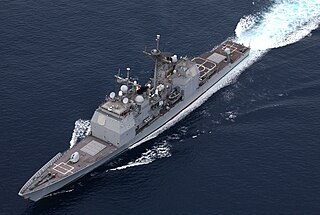
The Aegis Combat System is an American integrated naval weapons system, which uses computers and radars to track and guide weapons to destroy enemy targets. It was developed by the Missile and Surface Radar Division of RCA, and it is now produced by Lockheed Martin.
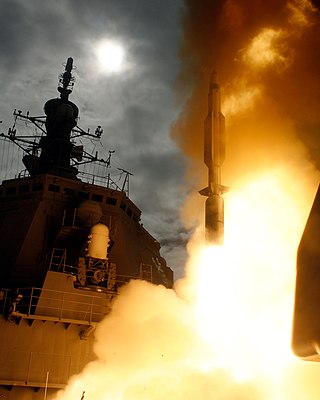
A guided-missile destroyer (DDG) is a destroyer whose primary armament is guided missiles so they can provide anti-aircraft warfare screening for the fleet. The NATO standard designation for these vessels is DDG, while destroyers which have a primary gun armament or a small number of anti-aircraft missiles sufficient only for point-defense are designated DD. Nations vary in their use of destroyer D designation in their hull pennant numbering, either prefixing or dropping it altogether.

USS Arleigh Burke (DDG-51), named for Admiral Arleigh A. Burke, USN (1901–1996), is the lead ship of the Arleigh Burke-class guided-missile destroyers. She was laid down by the Bath Iron Works company at Bath, Maine, on 6 December 1988; launched on 16 September 1989; and commissioned on 4 July 1991.

The Spruance-class destroyer was developed by the United States to replace the many World War II–built Allen M. Sumner- and Gearing-class destroyers, and was the primary destroyer built for the United States Navy during the 1970s and 1980s. It was named in honor of U.S. Navy Admiral Raymond A. Spruance, who successfully led major naval battles in the Asiatic-Pacific Theater during World War II such as the Battle of Midway and the Battle of the Philippine Sea.

The Charles F. Adams class is a ship class of 29 guided-missile destroyers (DDG) built between 1958 and 1967. Twenty-three were built for the United States Navy, three for the Royal Australian Navy, and three for the West German Bundesmarine. The design of these ships was based on that of Forrest Sherman-class destroyers, but the Charles F. Adams class were the first class designed to serve as guided-missile destroyers. 19 feet (5.8 m) of length was added to the center of the design of the Forrest Sherman class to carry the ASROC launcher. The Charles F. Adams-class were the last steam turbine-powered destroyers built for the U.S. Navy. Starting with the succeeding Spruance-class, all U.S. Navy destroyers have been powered by gas turbines. Some of the U.S. Charles F. Adams class served during the blockade of Cuba in 1962 and during the Vietnam War; those of the Royal Australian Navy served during the Vietnam War and Gulf War.

The Ticonderoga class of guided-missile cruisers is a class of warships of the United States Navy, first ordered and authorized in the 1978 fiscal year. It was originally planned as a class of destroyers. However, the increased combat capability offered by the Aegis Combat System and the passive phased array AN/SPY-1 radar, together with the capability of operating as a flagship, were used to justify the change of the classification from DDG to CG shortly before the keels were laid down for Ticonderoga and Yorktown.
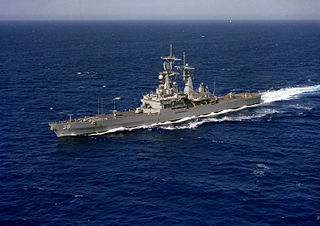
The Virginia class were four nuclear-powered, guided-missile cruisers that served in the United States Navy until the mid-to-late 1990s. The double-ended cruisers were commissioned between 1976 and 1980. They were the final class of nuclear-powered cruisers completed and the last ships ordered as Destroyer Leaders under the pre-1975 classification system.

Mark 32 Surface Vessel Torpedo Tubes is a torpedo launching system designed for the United States Navy.
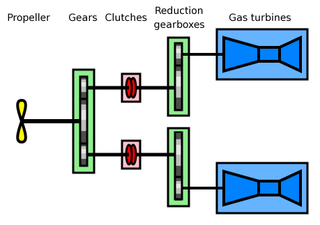
Combined gas turbine and gas turbine (COGAG) is a type of propulsion system for ships using two gas turbines connected to a single propeller shaft. A gearbox and clutches allow either of the turbines to drive the shaft or both of them combined. Marine usage of COGAG systems are similar to those found ashore.

The AN/SQQ-89 Undersea Warfare Combat System is a naval anti-submarine warfare (ASW) system for surface warships developed by Lockheed Martin for the United States Navy. The system presents an integrated picture of the tactical situation by receiving, combining and processing active and passive sensor data from the hull-mounted array, towed array and sonobuoys. AN/SQQ-89 is integrated with the AEGIS combat system and provides a full range of undersea warfare (USW) functions including active and passive sensors, underwater fire control, onboard trainer and a highly evolved display subsystem. It provides detection, classification, and targeting capability to the following platforms:
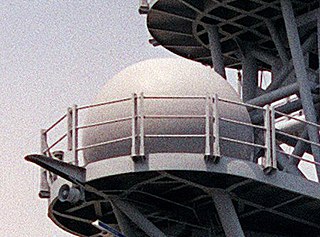
AN/SPQ-9A,, is a United States Navy multi-purpose surface search and fire control radar used with the Mk-86 gun fire-control system. It is a two dimensional surface-search radar, meaning it provides only range and bearing but not elevation. It is intended primarily to detect and track targets at sea level, on the surface of the water for either gun fire engagement or navigation. It can however, also detect and track low altitude air targets.
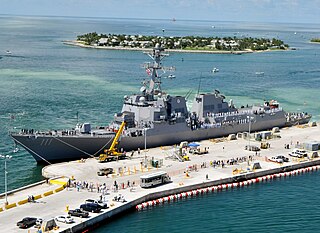
USS Spruance (DDG-111) is a United States Navy Arleigh Burke-class destroyer. She is the 61st ship in her class. Spruance is the second ship to be named for Admiral Raymond A. Spruance (1886–1969), who commanded American naval forces at the Battles of Midway and the Philippine Sea. He was later Ambassador to the Philippines. Her keel was laid down on 14 May 2009. She was christened by the admiral's granddaughter, Ellen Spruance Holscher, on 5 June 2010 in Bath, Maine at Bath Iron Works, where the ship was built at a cost of $1 billion. The completed ship left Bath on 1 September 2011 for her commissioning in Key West, Florida on 1 October 2011.

The RIM-66 Standard MR (SM-1MR/SM-2MR) is a medium-range surface-to-air missile (SAM), with a secondary role as an anti-ship missile, developed for the United States Navy (USN). A member of the Standard Missile family of weapons, the SM-1 was developed as a replacement for the RIM-2 Terrier and RIM-24 Tartar that were deployed in the 1950s on a variety of USN ships. The RIM-67 Standard (SM-1ER/SM-2ER) is an extended range version of this missile with a solid rocket booster stage.

USS Michael Murphy (DDG-112) is the 62nd ship of the Arleigh Burke class of guided missile destroyers in the United States Navy. She is named for Medal of Honor recipient Lieutenant Michael P. Murphy (1976–2005). Murphy was posthumously awarded the Medal of Honor for his actions during Operation Red Wings in Afghanistan in June 2005. He was the first sailor awarded the Medal of Honor since the Vietnam War. The ship's name was announced by Secretary of the Navy, Donald C. Winter on 7 May 2008. The ship was christened on 7 May 2011, Murphy's birthday, by her sponsor Maureen Murphy, Michael Murphy's mother. The ship is part of Destroyer Squadron 31 of Naval Surface Group Middle Pacific.

The AN/SPY-1 is a United States Navy 3D radar system manufactured by Lockheed Martin. The array is a passive electronically scanned system and a key component of the Aegis Combat System. The system is computer controlled and uses four complementary antennas to provide 360-degree coverage. The system was first installed in 1973 on USS Norton Sound and entered active service in 1983 as the SPY-1A on USS Ticonderoga. The -1A was installed on ships up to CG-58, with the -1B upgrade first installed on USS Princeton in 1986. The upgraded -1B(V) was retrofitted to existing ships from CG-59 up to the last, USS Port Royal.

The Mark 41 Vertical Launching System is a shipborne missile canister launching system which provides a rapid-fire launch capability against hostile threats. The Vertical Launch System (VLS) concept was derived from work on the Aegis Combat System.

The Mark 34 Gun Weapon System (GWS) is a component of the Aegis Combat System that is responsible for controlling and providing fire control to the 5" Mark 45 gun. It is used on the U.S. Navy Arleigh Burke-class destroyer and several later Ticonderoga-class cruisers. The Mk 34 GWS receives target data from the ship's sensors and off-ship sources, performs ballistic calculations, and produces gun control orders. The system is made up of the gun mount itself, the fire-control computer, and an optical sight.

Helicopter Maritime Strike Squadron Three Seven (HSM-37) "Easyriders" is a United States Navy helicopter squadron based at Marine Corps Base Hawaii. HSM-37 provides helicopter resources for all Arleigh Burke-class destroyers and Ticonderoga-class cruisers based at Pearl Harbor. The squadron was established as Helicopter Anti-Submarine Squadron (Light) Three Seven (HSL-37) on 3 July 1975 and was redesignated HSM-37 on 1 October 2013.

The DDG(X) or Next-Generation Guided-Missile Destroyer program of the United States Navy aims to develop a class of surface combatants to succeed 22 Flight II Ticonderoga-class cruisers and 28 Flight I/II Arleigh Burke-class destroyers. The program is the culmination of the Large Surface Combatant (LSC) initiative that followed the cancellation of CG(X) and curtailing of the procurement of the Zumwalt-class destroyers. The ships will become the principal large surface combatants of the U.S. Navy; compared to their predecessors, they will incorporate more powerful sensors and have more room and weight margin for growth.



















